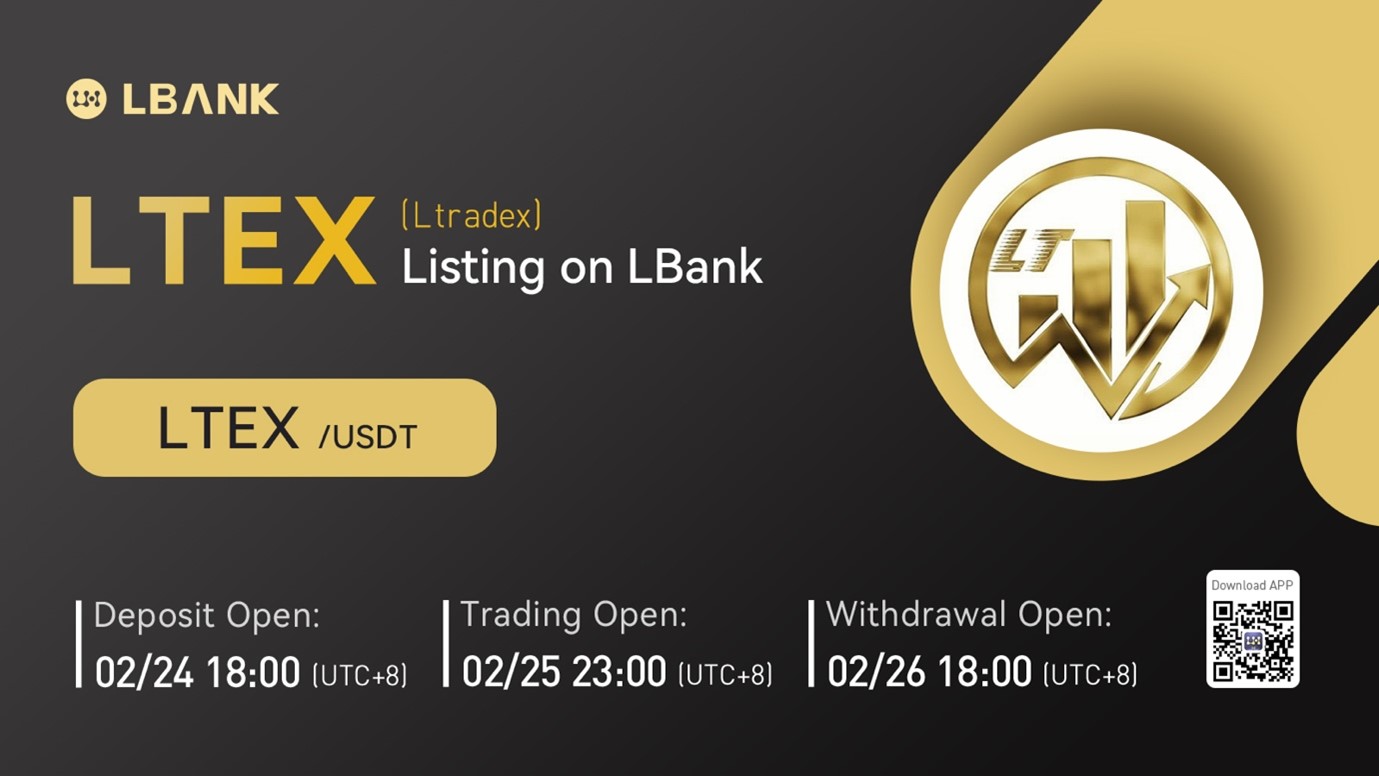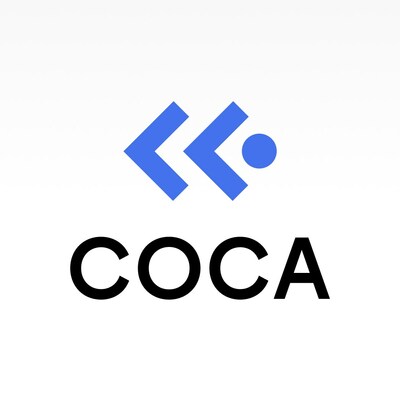Latest News
LBank Exchange Will List LTradex (LTEX) on February 25, 2022

Internet City, Dubai–(Newsfile Corp. – February 24, 2022) – LBank Exchange, a global digital asset trading platform, will list LTradex (LTEX) on February 25, 2022. For all users of LBank Exchange, the LTEX/USDT trading pair will be officially available for trading at 23:00 (UTC+8) on February 25, 2022.
Figure 1: LBank Exchange Will List LTradex (LTEX) on February 25, 2022
The era of crypto has arrived, and numerous cryptocurrencies have been created since the beginning of this era. To distinguish itself from other ones, LTEX token is establishing its own exchange, which is LTradex, rewards its holders through redistribution, and uses burning mechanisms to maintain deflationary. It provides privacy, security, power, and autonomy to its users, and offers an innovative, user-friendly one-stop shop with features including wallet, staking, bridge and many more. LTEX token will be listed on LBank Exchange at 23:00 (UTC+8) on February 25, 2022, to further expand its global reach and help it achieve its vision.
Introducing LTradex
LTradex (LTEX) is the first token in the world that proves its existence officially, publicly and legally by announcing its intentions of opening representing offices all over the globe. Its mission is to take the token to new heights by offering an innovative, user-friendly one-stop shop to let users find everything they need, and to give every person in the world an equal chance to manage their financial security.
With features such as exchange, wallet, reward system, staking, bridge and burning mechanism, LTradex lowers the barrier for entry to this financial ecosystem. The exchange platform it is establishing is also called LTradex, users will be able to register all fair tokens and exchange them on it. Additionally, LTradex has its own wallet, which is fast, and highly focused on enabling users to manage their coins and interact with the ecosystem. Users can hold or swap tokens, and donate or vote for the organization by using LTEX wallet. The bridge LTEX created allows users to swap BEP-20 and ERC-20 based tokens. It’s a unique cross-chain solution without the involvement of 3rd party.
Staking is fully supported for LTEX token as a practice of gaining passive income by merely storing or locking funds in a wallet. Moreover, LTEX intends to execute a long-term burn strategy which reduces the supply and makes the LTEX token scarcer.
LTEX is operated as a community-focused and community-driven digital assets that is fully decentralized, it envisions a world where wealth-building strategies that were once only accessible to affluent individuals become available to everyone.
About LTEX Token
As an advanced cryptocurrency based on BEP-20, LTEX token is easy to use, and provides users with transparency, immutability, and lower fees compared to debit, credit cards transactions, as well as wire transfers, and BACS payments. It’s open for global participants.
The total supply of LTEX token is 50 trillion (i.e. 50,000,000,000,000), 42.1% of it is provided for sale, 22.5% is provided for holders, and the rest 35.4% will be burned. It collects 6.5% taxes on each transaction, 4.5% of it will be redistributed to holders, and the rest 2% will be burned.
LTEX will be listed on LBank Exchange at 23:00 (UTC+8) on February 25, 2022, investors who are interested in LTradex investment can easily buy and sell LTEX on LBank Exchange by then. The listing of LTEX on LBank Exchange will undoubtedly help it further expand its business and draw more attention in the market.
Learn More about LTEX Token:
Official Website: https://ltradex.io/
Telegram: https://t.me/LTEXCommunityWorldwide
Twitter: https://twitter.com/LtexToken
Facebook: https://www.facebook.com/ltex.trade
Instagram: https://www.instagram.com/ltex_community
About LBank Exchange
LBank Exchange, founded in 2015, is an innovative global trading platform for various crypto assets. LBank Exchange provides its users with safe crypto trading, specialized financial derivatives, and professional asset management services. It has become one of the most popular and trusted crypto trading platforms with over 6.4 million users from now more than 210 regions around the world.
Start Trading Now: lbank.info
Community & Social Media:
l Telegram
l Twitter
l Facebook
l Linkedin
Contact Details:
LBK Blockchain Co. Limited
LBank Exchange
media@lbank.info
PR Contact:
ZEXPRWIRE
info@zexprwire.com
To view the source version of this press release, please visit https://www.newsfilecorp.com/release/114605
Powered by WPeMatico
Latest News
COCA Celebrates Q2 2024 with Record-Breaking Milestones and New Launches
HONG KONG, Aug. 7, 2024 /PRNewswire/ — COCA, a pioneering force in the crypto wallet and financial services industry, has achieved several remarkable milestones in Q2 2024. Thanks to the steadfast support of its user community, COCA has launched new features, expanded its partnerships, and garnered prestigious accolades, further solidifying its position as a leader in the crypto space.
Launch of Physical Cards
COCA has introduced its highly anticipated physical cards, which are now available globally and compatible with Apple Pay and Google Pay. These cards allow users to make transactions with ease, earning cashback rewards on their purchases. This significant launch marks a step forward in integrating crypto with everyday financial activities, enhancing user convenience and financial flexibility.
Wallet Growth Milestone
The company has reached a significant milestone with 510,000 active wallets, reflecting a 102% growth quarter-on-quarter. This surge in active wallets highlights the increasing trust and adoption of COCA’s platform, as more users join the COCA community to manage their crypto assets securely and efficiently.
Transaction Volume Surge
In Q2 2024, COCA processed over USD 450,000 in transactions through its platform, demonstrating the robust usage and popularity of its financial services. This impressive transaction volume underscores COCA’s commitment to providing smooth and efficient crypto payment solutions.
Integration with Revolut
COCA has made it easier for users to fund their wallets by integrating with Revolut. This new feature allows seamless loading of crypto assets, enhancing the overall user experience and accessibility of COCA’s services.
Award Recognition
COCA has been honoured with the “Best Startup” award in the Financial Revolution category at CONF3RENCE & BLOCKCHANCE 2024. This award is a testament to COCA’s innovative approach and significant impact on the future of finance, recognizing its efforts in driving forward the digital financial ecosystem.
New Strategic Partnerships
COCA has formed strategic partnerships with industry leaders such as Wirex Pay and GoMining. These collaborations aim to provide users with enhanced rewards and a superior overall experience. The partnerships signify COCA’s dedication to expanding its ecosystem and delivering greater value to its users.
Welcoming Pavel Matveev
COCA is excited to announce the addition of Pavel Matveev, Founder of Wirex, to its team as a Strategy and Product Advisor. Pavel’s extensive experience and visionary approach are expected to drive COCA’s strategic initiatives and product development, contributing to the company’s continued growth and innovation.
Season 2 Point System Launch
Season 2 of COCA’s popular point system has launched, offering users the opportunity to earn points through various activities, including trades, referrals, holding assets, and spending with COCA cards. With a prize pool of USDT 3500 and 5 Wirex Pay Nodes, this season promises exciting rewards and increased user engagement. The season ends on August 9th, so users are encouraged to participate actively.
NFT Giveaway
In a special giveaway, COCA distributed 1000 GoMining NFTs to lucky users. These NFTs provide unique benefits, including enhanced mining capabilities and exclusive digital collectibles, adding significant value to the user experience.
For further details on COCA’s Q2 achievements and upcoming initiatives, visit the company’s blog.
Website: coca.xyz
COCA continues to redefine the crypto experience with its innovative solutions, seamless integrations, and user-focused approach. The company’s recent milestones and future plans highlight its commitment to leading the way in the digital financial landscape.
About COCA
COCA is a next-generation crypto super app designed to simplify and secure the crypto experience for users worldwide. With innovations in security, usability, and integration, COCA is at the forefront of the digital asset revolution. For more information, visit coca.xyz.
Photo – https://mma.prnewswire.com/media/2477245/COCA_Q2_2024.jpg
Logo – https://mma.prnewswire.com/media/2338075/4848605/COCA_Logo.jpg

![]() View original content:https://www.prnewswire.co.uk/news-releases/coca-celebrates-q2-2024-with-record-breaking-milestones-and-new-launches-302216619.html
View original content:https://www.prnewswire.co.uk/news-releases/coca-celebrates-q2-2024-with-record-breaking-milestones-and-new-launches-302216619.html

Latest News
Stake and Earn with KuCoin’s Innovative GemPool Platform
VICTORIA, Seychelles, Aug. 7, 2024 /PRNewswire/ — KuCoin, a leading global cryptocurrency exchange, is excited to announce the launch of GemPool, its innovative new platform that allows users to acquire token airdrops as a reward for staking their crypto assets. This unique product is designed to provide early access to emerging crypto projects while offering rewards for their existing holdings at zero cost. By staking respective tokens in separate pools, users can farm new tokens and gain a foothold in the latest developments within the cryptocurrency market.
GemPool also offers flexible staking terms, allowing users to stake and un-stake their assets anytime within the designated period without lock-up restrictions. This flexibility ensures that users can manage their assets according to their preferences and market conditions. Additionally, GemPool provides zero-cost rewards, enabling users to earn tokens while holding their existing cryptocurrencies. By staking their tokens, users contribute to the growth of promising new projects, supporting innovation and development within the crypto space. With completion of tasks offered, users are eligible to earn multiplier bonus and receive more rewards.
Users can participate by staking KCS, USDT, or other specified assets in designated pools. The rewards are earned according to the respective yields of the pools, ensuring a fair and exciting experience for all users.
For more information on how to participate and the benefits of GemPool, please visit the KuCoin GemPool page.
About KuCoin
Launched in September 2017, KuCoin is a leading cryptocurrency exchange with its operational headquarters in Seychelles. As a user-oriented platform with a focus on inclusiveness and community engagement. It offers over 900 digital assets across Spot trading, Margin trading, P2P Fiat trading, Futures trading, and Staking to its 34 million users in more than 200 countries and regions. KuCoin ranks as one of the top 6 crypto exchanges. KuCoin was acclaimed as “One of the Best Crypto Apps & Exchanges of June 2024” by Forbes Advisor and has been included as one of the top 50 companies in the “2024 Hurun Global Unicorn List”. Learn more at https://www.kucoin.com/.
Logo – https://mma.prnewswire.com/media/2356857/KuCoin_Horizontal_Green_LOGO_Logo.jpg
![]() View original content:https://www.prnewswire.co.uk/news-releases/stake-and-earn-with-kucoins-innovative-gempool-platform-302216471.html
View original content:https://www.prnewswire.co.uk/news-releases/stake-and-earn-with-kucoins-innovative-gempool-platform-302216471.html

Latest News
Trust Wallet Launches Gamified Education Platform and Loyalty Program to Enhance and Reward Web3 Learning
DUBAI, UAE, Aug. 7, 2024 /PRNewswire/ — Trust Wallet, the world’s leading self-custody Web3 wallet and Web3 gateway trusted by over 130 million users, has launched Trust Wallet Quests, a gamified education platform within the Trust Wallet mobile app which encourages users to earn points while exploring and learning about Web3.
Users can engage in task-based challenges ranging from quizzes to complex problem-solving scenarios composed of various DeFi and Web3 activities, all designed to deepen their understanding of blockchain technology and decentralized applications (dApps), and expose them to exciting opportunities within Web3. As an incentive, users will earn Trust Points, a loyalty-based points system designed to reward user activity within the Trust Wallet mobile app. With Trust Points, users can earn rewards upon the completion of specific tasks, making Web3 more rewarding and fun.
In the future, Trust Points will offer additional gamification features, such as unlocking achievements, badges, and levels. This interactive approach not only boosts individual learning but also contributes to broader community education and adoption of decentralized technologies, making Trust Wallet Quests a dynamic and exciting way to reward loyal users and engage with communities in Web3.
On the motive for launching Trust Wallet Quests, Eowyn Chen, CEO of Trust Wallet, stated: “The complex technology and fast-paced industry can be intimidating for both new and seasoned users. The introduction of Quests on Trust Wallet further solidifies our commitment to making it easier for millions to navigate Web3, aligning perfectly with our mission to build a seamless Web3 hub and open ecosystem for all.”
Nate Zou, Head of Product at Trust Wallet, highlighted what to expect from Trust Points and Trust Wallet Quests: “Trust Points and Quests are just the first iteration of a much-needed reward system for our community. Within 2024, we have plans to build on this, combining rewards with many of our other web3 product offerings. Overall, we envision this points system not only changing how users engage with Trust Wallet, but also encouraging more collaboration between Trust Wallet, our users and other web3 ecosystem players.”
Trust Wallet Quests and Trust Points are now available on both Android and iOS versions of Trust Wallet’s mobile app. Download here: https://short.trustwallet.com/TrustWalletQuests
About Trust Wallet
Trust Wallet is the self-custody, multi-chain Web3 wallet and Web3 gateway for people who want to fully own, control, and leverage the power of their digital assets. From beginners to experienced users, Trust Wallet makes it easier, safer, and convenient for millions of people around the world to experience Web3, access dApps securely, store and manage their crypto and NFTs, buy, sell, and stake crypto to earn rewards, all in one place and without limits.

Photo – https://mma.prnewswire.com/media/2475264/image.jpg
Logo – https://mma.prnewswire.com/media/2475420/Trust_Wallet_Core_Logo_Blue_Logo.jpg
![]() View original content:https://www.prnewswire.co.uk/news-releases/trust-wallet-launches-gamified-education-platform-and-loyalty-program-to-enhance-and-reward-web3-learning-302215130.html
View original content:https://www.prnewswire.co.uk/news-releases/trust-wallet-launches-gamified-education-platform-and-loyalty-program-to-enhance-and-reward-web3-learning-302215130.html

-

 Fintech4 days ago
Fintech4 days agoFintech Pulse: Your Daily Industry Brief – March 17, 2025 – Finastra, I2C, Fintech Australia, Mastercard, Paymentology, Rapyd, PayU Global Payment Organization
-

 Fintech PR7 days ago
Fintech PR7 days agoBingX Joins NBX 2025 as a Gold Sponsor: Empowering Blockchain Innovation
-

 Fintech PR22 hours ago
Fintech PR22 hours agoPlaycasino.co.nz Releases Comprehensive Guide to Online Casino Payment Methods for NZ Players
-

 Fintech4 days ago
Fintech4 days agoUP Fintech: Record-High Quarterly and Full-Year Revenue and Profit; Q4 Net Income Up Nearly 28x YoY; Global Client Assets Reach US$41.7 Billion
-

 Fintech5 days ago
Fintech5 days agoLytus Technologies announces 24% Revenue Growth for H1 FY2025
-

 Fintech3 days ago
Fintech3 days agoFintech Pulse: Your Daily Industry Brief – March 18, 2025 | Klarna, Affirm, Walmart, Zolve, Japanese Fintech, Safe Harbor, NovoPayment
-

 Fintech PR3 days ago
Fintech PR3 days agoEBANX announces Robert-Jan Lieben as new VP in Europe to boost e-commerce between EU and emerging markets
-

 Fintech2 days ago
Fintech2 days agoFintech Pulse: Your Daily Industry Brief – March 19, 2025: Featuring nuburu, SoFi Technologies, Velera Sparkman, Credit Sesame, UWS Comotion, Curinos
















